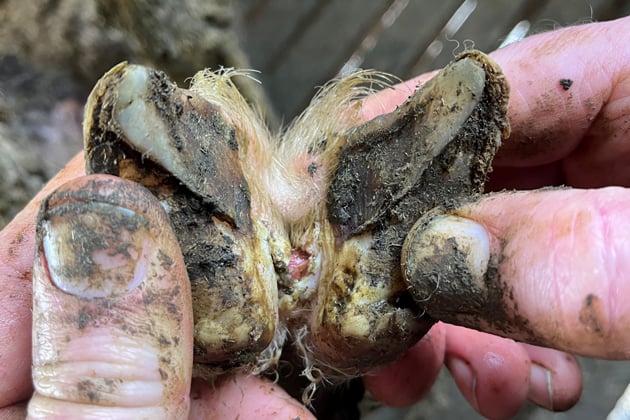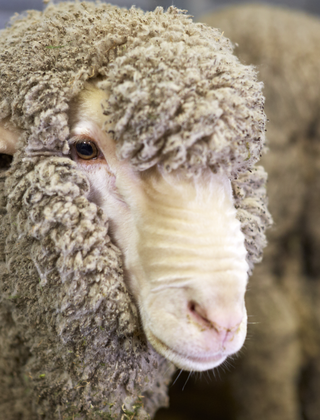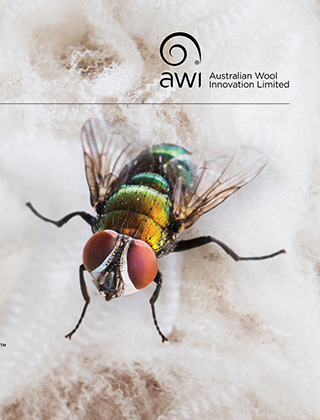Put your (sheep’s) best foot forward

There are many causes of lameness in sheep, ranging from short-lived and relatively mild, to severe. Bacteria cannot invade dry, healthy hooves, so keeping the feet of your sheep in the best possible condition helps them to fight off potential disease incursions.
Author: Emily King, AWI National Extension Manager
Foot health
Healthy, well-maintained feet are essential to the welfare of sheep. Bacteria cannot invade dry, healthy hooves, so keeping the feet of your sheep in the best possible condition helps them to fight off potential disease incursions.
The best way to have sheep with good feet is to breed them that way, then manage them well. Whilst this may sound overly simplistic, correct conformation and structure goes a long way to having sheep that stand well on their feet and maintain normal foot shape. There are many tools available to assist you in knowing and selecting sheep with good structure, such as the Visual Sheep Scores Guide.
Understand the normal shape of the sheep’s foot and how to pare (trim) feet, carefully avoiding over trimming. Over trimming can cause bleeding and pain, lead to the formation of toe granulomas, and open up the foot to infection.
If you need to undertake foot paring, observe sheep for lameness and bleeding. Keep any lame sheep or sheep with bleeding feet in a holding paddock with feed, water and shelter until they have recovered.
Thoroughly inspect rams’ feet prior to purchase, and again 8–12 weeks before joining. Pare to the normal shape if required.
What is causing the lameness I’m seeing in my sheep?
Lameness can be subtle or obvious, so be on the lookout for:
- weight not borne evenly on all legs
- obvious discomfort when moving or standing
- uneven posture, even without obvious shortening of stride
- uneven stride or short steps
- head bobbing in time with the short stride – shoulder may also drop
- excessive flicking of the head
- refusal to walk or to stand
- bunny hopping or taking pressure off sore front feet by hopping on back feet (e.g. toe abscess)
- carrying one leg when standing or walking.
There are many causes of lameness in sheep, ranging from short-lived and relatively mild, to severe. Some common foot issues sheep are prone to include:
- Foot abscess – usually only one foot affected with swelling and pus.
- Scabby mouth – affects skin above the hoof and has dark scabs.
- Shelly hoof (toe) – a natural and dry separation of the outside of the hoof horn beside the toe. The resulting cavity may contain mud, faeces or stones and may become flystruck.
- Bruising – lameness in soft feet without other signs.
- Ovine interdigital dermatitis (OID) – inflammation of interdigital skin during warm, wet weather. There is no under-run and OID heals quickly if feet are kept dry, such as overnight on battens. This condition is not uncommon, creates an ideal environment for footrot bacteria to infect, appears similar to the early stages of virulent footrot and is very similar to benign footrot.
- Strawberry footrot – scabs on skin at back of foot above the hoof, hot and swollen foot.
- Footrot – contagious, bacterial disease of the feet of sheep with significant welfare and economic impacts.
Lameness in sheep results in significant welfare concerns, as well as economic loss from reduced wool production (both quality and quantity), weight loss, lower growth rates, reduced ewe fertility, reduced ram activity, increased flystrike risk, and reduced value of sale sheep.
Is it footrot?
Footrot is a contagious, bacterial disease of the feet of sheep with significant welfare and economic impacts. While the number of flocks with virulent (severe) strains of footrot has reduced considerably over the last 20 years, footrot remains a serious disease.
Footrot is caused by the bacteria Dichelobacter nodosus. There are many strains of D. nodosus and they vary in the severity of the disease they cause. In an infected flock, multiple strains of D. nodosus may be present.
D. nodosus can survive in the environment for up to 7 days but can live in the foot of a sheep for years and is introduced to a clean flock by infected sheep. In some cases, sheep walking on contaminated ground or pasture can become infected.
Warm, moist environmental factors and long grass make sheep susceptible to footrot – these conditions are known as a spread period. The disease develops when there is:
- an average daily temperature of 10°C or higher, lasting for 4–5 days;
- adequate moisture; and
- adequate pasture length and density to keep the ground moist and make feet susceptible to infection.
The bacteria dies under hot, dry conditions.
Regulations for the diagnosis and management of footrot in sheep varies between states, but in most states footrot is a notifiable disease. Check the regulations for your state here.
The AWI Farmer footrot tool helps footrot-affected growers to understand the financial cost of the disease on their farm and evaluate the cost effectiveness of different strategies to control or eradicate the disease.
There are three versions of AWI’s Footrot: A guide to identification and control in the field – one each for Tasmania, South Australia and New South Wales. The ute guide outlines the disease’s cause, symptoms, treatment, management and eradication options. There’s also more information in Making More From Sheep Tool 11.13 Diagnosis, control and eradication of footrot, lice, JD and OB.
Keep it out
As with most diseases, prevention really is better than cure.
Footrot can be eradicated from flocks, but it’s often at considerable expense. Success with eradication programs is often season-dependent, as wet, warm conditions favour footrot.
So how do you keep disease off your farm in the first place? Use these key tips to minimise your risk:
- Secure boundary fences – most diseases are prevented by secure boundary fences.
- Ask for a National Sheep Health Declaration – review it before buying and transporting the sheep to your property to ensure the sheep match your disease status and you’re happy the risk they present is appropriate to your situation.
- Quarantine all introductions – place all sheep in quarantine on arrival. Small numbers of sheep, such as rams, may be individually inspected several times before their release onto your property, but always follow quarantine periods with larger mobs. Footbathing sheep off trucks is only a superficial disinfectant and will not clear existing footrot infections.
- Reduce the number of sheep you buy in – the more sheep you buy, the greater the risk of disease introduction, so buy as few mobs as possible and get advice from your veterinarian or sheep health advisor regarding possible risks.
- Get sheep from a reputable source – sheep from properties where regular trading occurs, with poor management or poor fences, are more likely to have disease problems.
- Agistment – always quarantine your sheep that have been away on agistment when they return home as they could have been exposed to several potential disease sources (e.g., roads, stray or resident sheep on agistment property, trucks, etc.).
- Sheep on roadways and in trucks – may be a risk if you are uncertain of stock movements with neighbours or stray sheep or in trucks.
- Contractors – equipment or staff may spread diseases, such as lice or footrot, if hygiene procedures are not observed.
Check out Making More From Sheep Tool 11.14 Minimising the risk of potential sources of disease for more tips and tricks.
If you'd like to hear a grower perspective on managing and eradicating footrot, watch the Clothier family in this short video from AWI Extension SA detailing their experiences at Woolumbool, SA.
More information
- AWI & MLA Visual Sheep Scores Guide
- MLA A producer’s guide to sheep husbandry practices – Inspecting and paring feet
- AWI Farmer footrot tool
- AWI Footrot
- Making More From Sheep Tool 11.13 Diagnosis, control and eradication of footrot, lice, JD and OB
- Making More From Sheep Footrot fact sheet
- AWI Footrot: A guide to identification and control in the field – state versions for:
- Footrot information by state:
- New South Wales – NSW Department of Primary Industries and Regional Development
- Queensland – Department of Primary Industries
- South Australia – Department of Primary Industries and Regions
- Tasmania – Department of Natural Resources and Environment Tasmania
- Victoria – Agriculture Victoria
- Western Australia – Department of Primary Industries and Regional Development WA
- Farm Biosecurity – Sheep
- Making More From Sheep Chapter 11.2 Plan an integrated health management program
- Making More From Sheep Chapter 11.3 Adopt on-farm biosecurity measures
- Making More From Sheep Tool 11.14 Minimising the risk of potential sources of disease
- Making More From Sheep Tool 11.15 Quarantine periods for important sheep diseases
- AWI Extension SA Case study: Managing footrot at Greenvale, Woolumbool with Sam, Oliver, Karen and Graham Clothier














